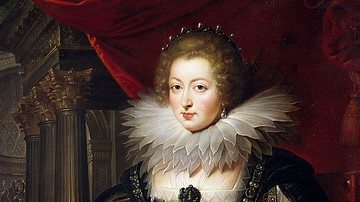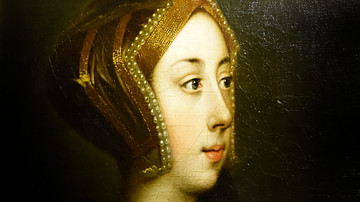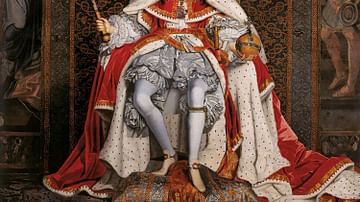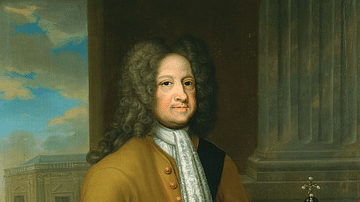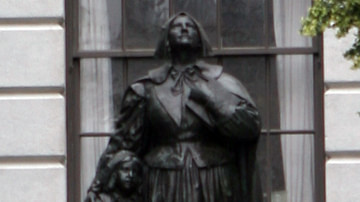
Anne reigned as Queen of England, Scotland, and Ireland from 1702 and then, following the 1707 Act of Union, over a united kingdom as Queen of Great Britain until her death in 1714. The last of the Stuart monarchs, Anne's reign witnessed the Spanish War of Succession which helped Britain establish itself as a major world power.
The Stuart Family
James II of England (r. 1685-1688) took over the throne from his late brother Charles II of England (r. 1660-1685) since the latter had no legitimate heir. James was a Catholic, but part of the deal which allowed him to succeed his Protestant brother in 1685 was that he promise to raise his two daughters as Protestants. James' first wife was Anne Hyde, the daughter of the Earl of Clarendon (m. 1660). The couple had two daughters: Mary (b. 1662) and the younger Anne, born on 6 February 1665 at St. James' Palace. Anne Hyde died of illness in 1671, and King James married again, this time to Mary (d. 1718), the daughter of the Duke of Modena. The royal couple had a son, James Francis Edward, who was born on 10 June 1688. There were rumours that the prince was an outsider brought in for convenience, and Anne herself had her suspicions about his legitimacy. The birth relegated Mary and Anne to second and third in line to the throne respectively. For Anne, in particular, the improbable likelihood of her becoming the monarch meant that she did not receive the education or preparation enjoyed by other future sovereigns.
The arrival of a new heir to the throne, who would surely be brought up a Catholic like both his parents, coupled with the king's pro-Catholic policies and authoritarian manner seriously worried many in Parliament. In order to maintain the integrity of Parliament and the achievements of the English Reformation and the primacy of Protestantism in England, several nobles now looked abroad for an alternative king. The obvious choice was William, Prince of Orange. The Dutchman was a Protestant and, in command of a powerful navy, he would be a very useful ally. Further, William was closely connected to the British royal family. William was, through his mother, the grandson of Charles I of England (r. 1625-1649), and he had married James II's daughter Mary in 1677. William was keen to have England's navy, professional army, and resources to aid him in his ongoing conflict with Louis XIV of France (r. 1643-1715).
As it turned out, William's invasion of England was remarkably tranquil, and King James, seeing desertions left, right, and centre – including by his daughter Anne – took the prudent action of escaping to France. This was the Glorious Revolution of 1688. The Prince of Orange became William III of England and his wife Mary II of England (r. 1689-1694). The two ruled jointly until Mary died of smallpox in December 1694. Anne had an uneasy relationship with William whom she described in letters with derogatory terms such as "the Dutch monster" (Cannon, 308). Largely, the royal in-laws kept their relationship distant and formal.
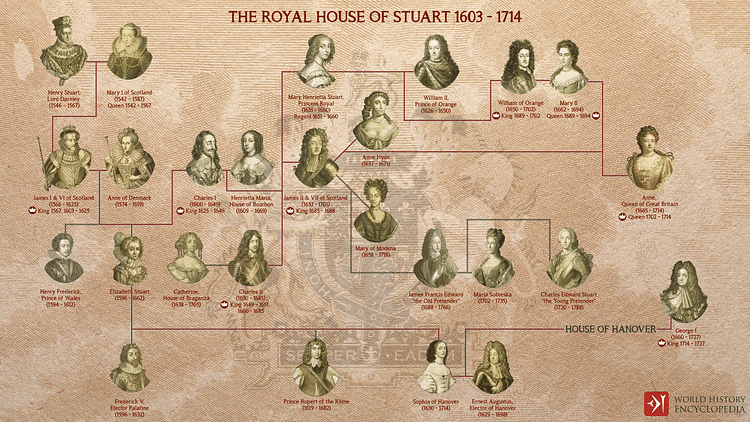
Succession
William and Mary had no surviving children and so the late Mary's sister Anne was declared the official heir in February 1695. William died as the consequence of a riding accident on 8 March 1702. James II, still in exile in France, had died in 1701, but his son James (the Old Pretender) and grandson Charles (the Young Pretender) both carried on the flame of rebellion, especially in the Scottish Highlands. Nevertheless, Anne's throne was secure. The queen was, though, like William and Mary before her, now part of a constitutional monarchy, where Parliament was much more powerful than earlier Stuart times. In the decade or so following the Glorious Revolution, Parliament had gained the ultimate authority in the key areas of passing laws and raising taxes. No monarch could henceforth maintain their own standing army, only Parliament could declare war, and any new monarch had to swear at their coronation to uphold the Protestant Church. The monarch could not now dismiss Parliament on a whim and their accounts were controlled by the Civil List.
Anne was crowned in Westminster Abbey on 23 April 1702; she was 37 years old. She had married Prince George of Denmark (1653-1708), the son of Frederick III of Denmark (r. 1648-70) on 28 July 1683. King William made George the Duke of Cumberland, but he was largely ignored until Anne became queen, and even then his disinterest in political life ensured he remained a marginal figure. The couple had many children, but unfortunately, all but one died very young or were stillborn. The sole heir was William, Duke of Gloucester (b. 1689), but he, too, was a sickly child, and he died aged 12.

Key Reign Events
Personal Companions
Anne took a keen interest in her role as part of the apparatus of a constitutional monarchy. For example, she often sat in on cabinet meetings and even debates in the House of Lords, disguising herself as an ordinary woman. She knew her own mind and resisted pressure from others as seen even before her succession in the Churchill affair. John Churchill (future Duke of Marlborough, 1650-1722) was suspected of plotting a return of James II, and so Princess Anne was advised that Churchill's wife Sarah Jenyns (also spelt Jennings) was no longer a suitable member of her court. Although Anne had approved of William and Mary's Glorious Revolution, the princess refused to dismiss Sarah, causing the displeasure of her sister Queen Mary and resulting in her expulsion from Whitehall Palace. The two Stuart sisters never spoke to each other again. Eventually, Queen Anne tired of Sarah Jenyns' company – the final straw was a public argument outside St. Paul's Cathedral over costume – and her new favourite became Abigail Masham. The queen's relationships with her closest female confidantes led to gossip and speculation that Anne was a lesbian.
Whigs & Tories
Anne's reign was a turbulent time in terms of politics. This was the period that saw a clearer formation of political parties. There were two main groups in Parliament: the Whigs and the Tories. The Whigs were a mix of wealthy landowners, business owners, and financial speculators. They were staunch defenders of Parliamentary powers and so only wished to see a very limited monarchy. The Tories were more reactionary and largely made up of country gentry who believed in the two great traditions of monarchy and church. Anne was above party politics, as she herself once stated: "All I desire is my liberty in encouraging and employing all those that concur faithfully in my service, whether they are Whigs or Tories" (Dicken, 256). Anne left affairs of state to her key ministers like the Lord Treasurer, Sidney, Baron Godolphin, the Secretary of State Robert Harley, and John Churchill (back in favour) who headed the armed forces and took charge of diplomatic affairs.
War of Spanish Succession
It was rare indeed for a monarch to enjoy an entirely peaceful reign, and Anne was no exception. The War of Spanish Succession of 1701-14 saw most of Europe become embroiled in just who should inherit the Spanish Empire after the death of Charles II of Spain. The conflict saw England gain several important victories, notably the taking of Gibraltar by Admiral Rooke in 1704 and, later in the same year, the great victory at the Battle of Blenheim in Germany which was masterminded by the Duke of Marlborough. In gratitude, Anne ensured public funds went into the building of the Churchill family home, the magnificent Blenheim Palace in Oxfordshire. More impressive British victories came in Ramillies in 1706 and Oudenarde in 1708. In 1713-15, the Treaty of Utrecht ended the War of Spanish Succession and resulted in an enlargement of the British colonies in North America (Newfoundland and Nova Scotia) and a lucrative monopoly contract to ship slaves from Africa to colonies of the Spanish Empire.
Act of Union
More key events included, in 1705, Britain's first copyright law being passed by Parliament, the Statute of Anne. In 1707, the Act of Union formally joined England and Scotland into a single kingdom now called Great Britain. This came about really in order to limit the possibility of the Scots returning to an independent monarch, such was their dislike of Anne's official heirs, the Hanoverian family, selected as such in the 1701 Act of Settlement. Under the Act of Union, the Scottish and English parliaments became one (with Westminster expanded to include 45 Scottish MPs), the currency of the two realms was made the same, free trade was granted, and a union flag adopted. The Scottish Presbyterian church, judiciary, and education system all remained independent. In order to pass through the act, multiple bribes were paid to Scottish nobles and a lump sum of £400,000 paid to Scotland. These behind-the-scenes efforts failed, though, to prevent riots of protest occurring in Edinburgh and Glasgow. The Act of Union was passed by the Scottish Parliament on 16 January 1707 and by the English Parliament on 6 March. The year 1707 also saw the first general elections. 1708 brought the completion of St. Paul's Cathedral in London, built according to a magnificent baroque design by Sir Christopher Wren.
Queen Anne Furniture
Queen Anne gave her name to a style of decorative arts, seen particularly in furniture and driven by the fashion for tea parties where small chairs, side tables, and cabinets were used. The style first appeared in the reign of her predecessor William III, and it continued to be popular after Anne's reign. Queen Anne furniture, still highly collectable today, is frequently made from walnut and includes the use of cabriole (double-curved) legs with a foot made to resemble a claw or paw. A feature of Queen Anne chairs is a back which curves to match the contours of the spine.
Ailing Health & Successor
Anne was a well-liked queen. Cheerful, and with a fine-speaking voice, she was successful in her wars abroad (she frequently headed processions to victory services at St. Paul's cathedral) and was a promotor of good causes. Anne cultivated her Englishness – she had stated in her accession speech that unlike her predecessor William of Orange, "I know my heart to be entirely English" (Cannon, 308). The queen particularly liked to associate herself with Elizabeth I of England (r. 1558-1603) and dressed accordingly. Anne was prone, like her mother, to corpulence, and her weight grew so that she was eventually obliged to use a sedan chair. Other physical ailments included rheumatism, gout, and eye problems.
Queen Anne outlived her husband George by six years; she died at the age of 49 on 1 August 1714 at Kensington Palace after suffering two strokes. The queen's outsize coffin was interred in Westminster Abbey. Anne was the last of the Stuart monarchs, which had begun with Robert II of Scotland (r. 1371-1390). She was succeeded by George Ludwig, Elector of Hannover, who became George I of England (r. 1714-1727). George was Anne's nearest relation of the Protestant faith – Parliament had passed a law forbidding a Catholic to take the throne – and the first monarch of the House of Hanover, which was connected to the Stuarts through the descendants of Elizabeth Stuart, daughter of James I of England (r. 1603-1625). The change of ruling house was an opportunity not missed by the Jacobites, those who still supported the royal line through James II's son, the Old Pretender. James Francis Edward Stuart refused to renounce his Catholicism to make himself more appealing to his subjects, and a Jacobite rising was quashed in Scotland in 1715. So the Protestant monarchy of Britain continued as Queen Anne would have wished.


